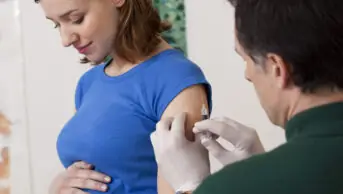
Shutterstock.com
A study of women vaccinated with the quadrivalent human papillomavirus (HPV) vaccine while at school has added to evidence that the strategy reduces the rate of abnormalities detected via cervical screening.
The research looked at data from 10,204 women born between 1994 and 1997 who had been vaccinated as part of a programme introduced in Alberta, Canada, in 2008. They received the HPV vaccine between the ages of 10 years and 15 years and were screened between the ages of 18 years and 21 years.
The team, led by Huiming Yang, medical director of screening at Alberta Health Services in Edmonton, found that women who received all three doses of the quadrivalent vaccine – which protects against HPV types 6, 11, 16 and 18 – were 28% less likely to have an abnormal cytology result than women who had no vaccination.
Looking only at high-grade abnormalities, which are more likely to develop into cervical cancer, the researchers found the risk was reduced by 50% in women who had received all three doses of the vaccination.
Overall, 4,492 (44%) women in the cohort were given at least one dose of the vaccine before cervical screening; 83.8% of these women were given all three doses.
However, there was no effect on cervical screening outcomes in women who had received only two doses of the vaccine.
Writing in CMAJ
[1]
(online, 4 July 2016), the researchers suggest this could be because the median time between the first and second doses was less than the recommended six months, adding that an Australian study with the recommended spacing between doses found that a two-dose schedule of vaccination was effective on cytology outcomes but not pathology.
In Canada, a two-dose schedule is permitted but is not policy. Yang and colleagues suggest that a switch to a two-dose schedule should be done with caution and describe the evidence for its efficacy as “inconclusive”.
But Kevin Pollock, an epidemiologist specialising in vaccination at Health Protection Scotland, disagrees. He suggests that the lack of efficacy of the two-dose vaccination shown in the Canadian study may have resulted from the low number of women who received two doses in the sample (n=490).
Pollock adds that the evidence showing that one or two doses of the HPV vaccine can reduce the rate of high-risk HPV infection is fairly conclusive. He was involved in a study using Scottish data[2]
, in which researchers found that bivalent HPV vaccination, which was initially used in the UK when the programme was introduced in 2008, was effective at reducing positive smear test results, even after only one dose. Pollock says that he would not expect results with the quadrivalent vaccine to be that different.
In 2014, the UK moved from a three-dose to a two-dose schedule based on observational and clinical trial data supporting its efficacy. “In Scotland, we have data linkage potential so we are pretty convinced of our data and that the vaccine is working well,” says Pollock.
The Canadian study echoes Scottish data, in that it shows that women who have been vaccinated are more likely to attend cervical screening than unvaccinated women (13.0% vs 11.4%). But the researchers say this may create a group of high-risk women who have neither the benefit of vaccination nor screening. They conclude that vaccination and screening programmes therefore need to be better integrated to optimise cervical cancer prevention.
The researchers also note that the efficacy of HPV vaccination means that the positive predictive value of cervical cytology screening will fall, which will mean it has reduced effectiveness.
In the UK, the National Screening Committee recommended in January 2016 that HPV testing should become the primary screening method, based on evidence from pilot sites in England and international evidence.
References
[1] Kim J, Bell C, Sun M et al. Effect of human papillomavirus vaccination on cervical cancer screening in Alberta. CMAJ 2016. doi: 10.1503/cmaj.151528
[2] K Cuschieri, K Kavanagh, C Moore et al. Impact of partial bivalent HPV vaccination on vaccine-type infection: a population-based analysis. British Journal of Cancer 2016;114:1261–1264. doi: 10.1038/bjc.2016.97
You may also be interested in

Maternal vaccination: rationale, recommendations and role of pharmacists

Community pharmacies have administered more than 8,000 RSV vaccines in east of England
